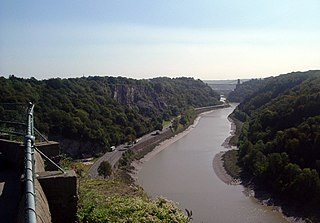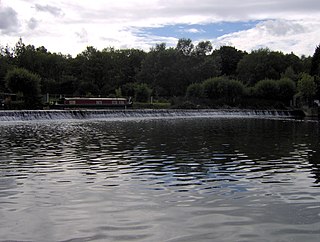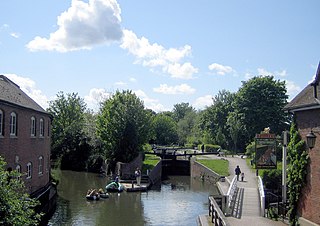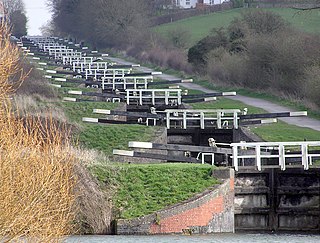
Newbury is a market town in the county of Berkshire, England, and is home to the administrative headquarters of West Berkshire Council. The town centre around its large market square retains a rare medieval Cloth Hall, an adjoining half timbered granary, and the 15th-century St Nicolas Church, along with 17th- and 18th-century listed buildings. As well as being home to Newbury Racecourse, it is the headquarters of Vodafone and software company Micro Focus International. In the valley of the River Kennet, 26 mi (42 km) south of Oxford, 25 mi (40 km) north of Winchester, 27 mi (43 km) southeast of Swindon and 20 mi (32 km) west of Reading.

The River Avon is a river in the south west of England. To distinguish it from a number of other rivers of the same name, it is often called the Bristol Avon. The name 'Avon' is a cognate of the Welsh word afon, meaning 'river'.

The Kennet and Avon Canal is a waterway in southern England with an overall length of 87 miles (140 km), made up of two lengths of navigable river linked by a canal. The name is used to refer to the entire length of the navigation rather than solely to the central canal section. From Bristol to Bath the waterway follows the natural course of the River Avon before the canal links it to the River Kennet at Newbury, and from there to Reading on the River Thames. In all, the waterway incorporates 105 locks.

Claverton Pumping Station in the village of Claverton, in the English county of Somerset, pumps water from the River Avon to the Kennet and Avon Canal using power from the flow of the River Avon. It is a Grade I listed building, having been upgraded from Grade II in 2019.

County Lock is a lock on the River Kennet in Reading town centre in the English county of Berkshire. It is now administered by the Canal & River Trust as part of the Kennet and Avon Canal. Downstream from the lock is Brewery Gut, a particularly fast flowing, narrow and dangerous stretch of the river.

Hanham Lock is a canal lock situated on the River Avon, at the village of Hanham near Bristol, England.

Keynsham Lock is a canal lock situated on the River Avon at Keynsham, England.

Saltford Lock is a canal lock situated on the River Avon, at the village of Saltford, between Bristol and Bath, England.

Kelston Lock is a canal lock situated on the River Avon, between the villages of Kelston and Saltford, between Bristol and Bath, England.

Weston Lock is a canal lock situated on the River Avon, on the western outskirts of Bath, England, in what now forms the Newbridge suburb of Bath.

Tyle Mill Lock is a lock situated near Tyle Mill and the village of Sulhamstead on the Kennet and Avon Canal, England.

Garston Lock is a lock on the Kennet and Avon Canal. It is near the M4 motorway and near Reading, England.

Sheffield Lock, at grid reference SU648706, is a lock on the Kennet and Avon Canal, in the civil parish of Burghfield in the English county of Berkshire. It is also sometimes known as Shenfield Lock.

Newbury Lock is a lock on the Kennet and Avon Canal in the town centre of Newbury, in the English county of Berkshire. It has a rise/fall of 3 ft 6 in, and is situated just upstream of Newbury Bridge.

Woolhampton Lock is a lock on the Kennet and Avon Canal, in the village of Woolhampton in the English county of Berkshire. The lock has a rise/fall of 8 feet 11 inches (2.72 m) and is administered by the Canal and River Trust.

Caen Hill Locks are a flight of 29 locks on the Kennet and Avon Canal, between Rowde and Devizes in Wiltshire, England.

John Hore was an English engineer, best known for making the River Kennet and River Avon navigable. Hore was one of the earliest English canal engineers, and Sir Alec Skempton wrote that he was "in the first rank among the navigation engineers". The Hutchinson Chronology of World History described his work on the Kennet navigation as "[setting] a new standard for inland waterways, and is an important forerunner of the canals of the Industrial Revolution".

Bridge Street, formerly known as Seven Bridges, is a historic street in the town of Reading in the English county of Berkshire. It took its original name from the seven bridges that carried it over various channels of the River Kennet, and was the earliest crossing place of that river in the town.
John Blackwell was an English civil engineer, known for his work as superintending engineer of the Kennet and Avon Canal under John Rennie and later as the canal company's resident engineer.




















